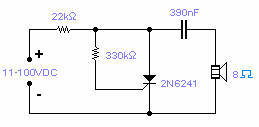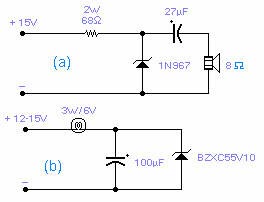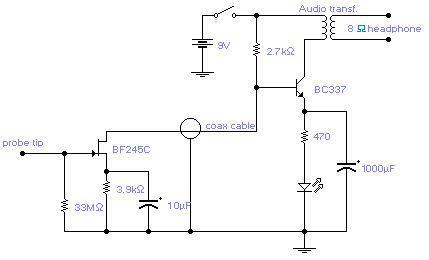POWER FLASHER
 There is no need to resort to complex
circuitry if what you are looking for is a simple power flasher. The
light will flash at around 1Hz with a 100W bulb at a duty cycle of 50%.
The max. load that can be driven with this circuit is 200W and if you
wish to have a different frequency you have to change the value of the
capacitor. Operation at 110VAC has not been tested although I expect it
to work provided the resistors are set at about half the stated value.
The SCR is manufactured by Siemens but any other equivalent
semiconductor, with standard gate sensitivity, should work fine.
WARNING! - This circuit is directly connected to the mains and proper
safety precautions should be taken. A more modern design would use a
sensitive gate SCR, other low power resistors and a 10?F,
250V electrolytic capacitor.
There is no need to resort to complex
circuitry if what you are looking for is a simple power flasher. The
light will flash at around 1Hz with a 100W bulb at a duty cycle of 50%.
The max. load that can be driven with this circuit is 200W and if you
wish to have a different frequency you have to change the value of the
capacitor. Operation at 110VAC has not been tested although I expect it
to work provided the resistors are set at about half the stated value.
The SCR is manufactured by Siemens but any other equivalent
semiconductor, with standard gate sensitivity, should work fine.
WARNING! - This circuit is directly connected to the mains and proper
safety precautions should be taken. A more modern design would use a
sensitive gate SCR, other low power resistors and a 10?F,
250V electrolytic capacitor.
SCR OSCILLATOR
 Silicon controlled
rectifiers (SCR) can easily oscillate if there is an inductor (a speaker
coil in this case) which gives just enough extra voltage to completely
switch off the sustain current. In this way a new cycle may start and
oscillations set in. It operates over a wide range of supply voltage and
components values are not critical at all. Operational frequency in this
circuit goes from 100Hz at 11V to 10KHz at 100V.
Silicon controlled
rectifiers (SCR) can easily oscillate if there is an inductor (a speaker
coil in this case) which gives just enough extra voltage to completely
switch off the sustain current. In this way a new cycle may start and
oscillations set in. It operates over a wide range of supply voltage and
components values are not critical at all. Operational frequency in this
circuit goes from 100Hz at 11V to 10KHz at 100V.
ZENER OSCILLATORS
 These two circuits are interesting from an academic point of
view. Their practical implementation is rather critical and it is not
easy to get steady operation. Circuit (a) requires a "cooked" zener:
connect it first to a constant current generator, then increase the
current until the voltage across the zener starts to decrease. Reduce
the supply current and wait a few minutes until it really warms up. The
zener is now ready for the circuit: increase the voltage slowly until it
oscillates (1KHz in the circuit shown). You may need to decrease the
voltage once oscillation takes place. With suitable circuit components
it will oscillate up to 20MHz. Circuit (b) will oscillate at a very low
frequency, normally 2-5Hz, provided the voltage is increased very
slowly, loading is critical and you may find that a slightly different
lamp will work better. Higher voltage zeners work better than low
voltage zeners and the circuits operate only with the specified types.
The reasons for the oscillations are unknown, although, for circuit (b)
it is felt that some kind of reversible thermal breakdown is at work.
These two circuits are interesting from an academic point of
view. Their practical implementation is rather critical and it is not
easy to get steady operation. Circuit (a) requires a "cooked" zener:
connect it first to a constant current generator, then increase the
current until the voltage across the zener starts to decrease. Reduce
the supply current and wait a few minutes until it really warms up. The
zener is now ready for the circuit: increase the voltage slowly until it
oscillates (1KHz in the circuit shown). You may need to decrease the
voltage once oscillation takes place. With suitable circuit components
it will oscillate up to 20MHz. Circuit (b) will oscillate at a very low
frequency, normally 2-5Hz, provided the voltage is increased very
slowly, loading is critical and you may find that a slightly different
lamp will work better. Higher voltage zeners work better than low
voltage zeners and the circuits operate only with the specified types.
The reasons for the oscillations are unknown, although, for circuit (b)
it is felt that some kind of reversible thermal breakdown is at work.
220V MAINS MONITOR
 With this circuit you will be able to monitor the quality of the
mains. There are 4 distinct sections, each supervising a parameter
pertinent to the quality of the supply line. The noise section consists
of a 50Hz filter and a speaker where you will hear the noise present on
the line. The bicolor LED should be adjusted for the least light with
the 5k pot and gives a visual indication of noise or asymmetry in the
wave. The second section will detect any spike which is overimposed on
the mains voltage: adjust the pot so that it will not trip if you just
switch on the light, sensitivity is high enough to detect a switching
operation from a close neighbor. The buzzer will beep for about 1sec
anytime there is a spike. The actual voltage is detected with section 3:
the yellow led will blink at a rate of 6 Hz but will visibly double to
12 Hz for a 10% increase or will come to a halt for a 10% decrease of
the voltage. The last section will show the flutter or slow variations
of the mains voltage. The circuit will work for a 220V mains: for 230V
operation, change the 27V zener to 39V and for 60Hz operation change the
3.9k resistor to 3.3k and the 47k resistor to 39k. Operation at 110V
will call for a major redesign of the component values and has not been
attempted.
With this circuit you will be able to monitor the quality of the
mains. There are 4 distinct sections, each supervising a parameter
pertinent to the quality of the supply line. The noise section consists
of a 50Hz filter and a speaker where you will hear the noise present on
the line. The bicolor LED should be adjusted for the least light with
the 5k pot and gives a visual indication of noise or asymmetry in the
wave. The second section will detect any spike which is overimposed on
the mains voltage: adjust the pot so that it will not trip if you just
switch on the light, sensitivity is high enough to detect a switching
operation from a close neighbor. The buzzer will beep for about 1sec
anytime there is a spike. The actual voltage is detected with section 3:
the yellow led will blink at a rate of 6 Hz but will visibly double to
12 Hz for a 10% increase or will come to a halt for a 10% decrease of
the voltage. The last section will show the flutter or slow variations
of the mains voltage. The circuit will work for a 220V mains: for 230V
operation, change the 27V zener to 39V and for 60Hz operation change the
3.9k resistor to 3.3k and the 47k resistor to 39k. Operation at 110V
will call for a major redesign of the component values and has not been
attempted.
ULTRA LOW FREQUENCY RECEIVER
 The frequency covered is from 0.1Hz to 10Hz and useful signals
are received up to 16Hz. The first Op-Amp, properly shielded, must be
installed close to the antenna (1-3m long) and connected to the rest of
the circuit with a 5-core shielded cable. Adjust the 100k trimmer so
that the DC setting at the output of the OPA124 does not change when
turning the 220k sensitivity pot. A low pass filter followed by a notch
filter take care of the mains induced noise. The values in brackets are
good for a 60Hz mains. 1% components should be used for the 3 resistors
and 3 capacitors of the notch filter. A voltage controlled oscillator
gives an audible frequency that follows the input signal and it is very
handy if the unit is made portable although I found that just walking
around is enough to bury the signal being received. The output signal
goes first to a meter and then is available for the connection to a data
logger, which is an almost essential part of the receiver. Sensitivity
is quite adequate: any TV set switching on in the area will be detected.
There are also a host of other mysterious signals of unknown origin. The
input protection diodes are special low leakage type and should not be
replaced by standard diodes. These diodes can be dispensed with if the
antenna is installed with care and away from strong electric fields. The
diodes connected to the meter are Schottky diodes and will provide a
bias against very small signals (mostly noise) which will not go through
to the data logger. Pin connection for OPA124: 1 and 5: DC set, 2 and 3:
inverting and non-inverting, 6: output, 8: substrate. Pin connection for
LF412: 2 and 3: inverting and non-inverting, 1: output, 6 and 5:
inverting and non-inverting, 7: output.
The frequency covered is from 0.1Hz to 10Hz and useful signals
are received up to 16Hz. The first Op-Amp, properly shielded, must be
installed close to the antenna (1-3m long) and connected to the rest of
the circuit with a 5-core shielded cable. Adjust the 100k trimmer so
that the DC setting at the output of the OPA124 does not change when
turning the 220k sensitivity pot. A low pass filter followed by a notch
filter take care of the mains induced noise. The values in brackets are
good for a 60Hz mains. 1% components should be used for the 3 resistors
and 3 capacitors of the notch filter. A voltage controlled oscillator
gives an audible frequency that follows the input signal and it is very
handy if the unit is made portable although I found that just walking
around is enough to bury the signal being received. The output signal
goes first to a meter and then is available for the connection to a data
logger, which is an almost essential part of the receiver. Sensitivity
is quite adequate: any TV set switching on in the area will be detected.
There are also a host of other mysterious signals of unknown origin. The
input protection diodes are special low leakage type and should not be
replaced by standard diodes. These diodes can be dispensed with if the
antenna is installed with care and away from strong electric fields. The
diodes connected to the meter are Schottky diodes and will provide a
bias against very small signals (mostly noise) which will not go through
to the data logger. Pin connection for OPA124: 1 and 5: DC set, 2 and 3:
inverting and non-inverting, 6: output, 8: substrate. Pin connection for
LF412: 2 and 3: inverting and non-inverting, 1: output, 6 and 5:
inverting and non-inverting, 7: output.
ELECTRIC FIELD DETECTOR
 The circuit will come handy when you have
to follow the mains wires buried in the wall or even water pipes
provided they are not too far away (2-4cm max). It will also detect a
conversation on a telephone cable without actually touching it (for
testing purposes only) and it works as a microphone if you keep a
plastic kitchen foil between the probe tip and your mouth. The probe is
just the 12mm long gate lead of the transistor. The 33M resistor should
be cut short and soldered where the lead enters the transistor case.
Connection to the other part of the circuit is via a standard coaxial
cable of any length. The input is not protected and a pair of low
leakage diodes (JPAD5) could be connected back to back between gate and
ground. I did not find them necessary: I covered, with a small piece of
plastic sponge, the probe tip to avoid direct contact with electrified
surfaces and used a minimum of care when handling the probe.
The circuit will come handy when you have
to follow the mains wires buried in the wall or even water pipes
provided they are not too far away (2-4cm max). It will also detect a
conversation on a telephone cable without actually touching it (for
testing purposes only) and it works as a microphone if you keep a
plastic kitchen foil between the probe tip and your mouth. The probe is
just the 12mm long gate lead of the transistor. The 33M resistor should
be cut short and soldered where the lead enters the transistor case.
Connection to the other part of the circuit is via a standard coaxial
cable of any length. The input is not protected and a pair of low
leakage diodes (JPAD5) could be connected back to back between gate and
ground. I did not find them necessary: I covered, with a small piece of
plastic sponge, the probe tip to avoid direct contact with electrified
surfaces and used a minimum of care when handling the probe.
SCR INVERTER
 The only drawback with this circuit is that it might latch in
the conducting state if the load is too heavy or if there is a short at
the output, this requires some kind of protection, on the input line, in
the form of a fuse or similar. The transformer used is a 10W mains type
with 6V+6V windings on the SCR side and a 110V+110V windings, in series,
at the output. Efficiency is 50% and the ideal load is equivalent to a
22k resistor, 5W. The output waveform is vaguely sinusoidal at a
frequency of 400Hz.
The only drawback with this circuit is that it might latch in
the conducting state if the load is too heavy or if there is a short at
the output, this requires some kind of protection, on the input line, in
the form of a fuse or similar. The transformer used is a 10W mains type
with 6V+6V windings on the SCR side and a 110V+110V windings, in series,
at the output. Efficiency is 50% and the ideal load is equivalent to a
22k resistor, 5W. The output waveform is vaguely sinusoidal at a
frequency of 400Hz.
SOUND TRIGGERED FLASH
 If you wish to take a picture of a fleeting event which
generates a sound, you can do it with this sound activated trigger. It
does not require any power supply: it feeds on the high voltage
available on the flash trigger terminal. Any economic ceramic microphone
is suitable for the purpose. The 68nF capacitor introduces a small delay
in the operation of the flash and may help in getting the picture in
exactly the right moment although you should expect to take several
shots for best results. With this circuit you will be able to catch a
cork leaving the champagne bottle or the moment a balloon is punctured.
The whole circuit could be assembled in the mike housing making a very
compact device.
If you wish to take a picture of a fleeting event which
generates a sound, you can do it with this sound activated trigger. It
does not require any power supply: it feeds on the high voltage
available on the flash trigger terminal. Any economic ceramic microphone
is suitable for the purpose. The 68nF capacitor introduces a small delay
in the operation of the flash and may help in getting the picture in
exactly the right moment although you should expect to take several
shots for best results. With this circuit you will be able to catch a
cork leaving the champagne bottle or the moment a balloon is punctured.
The whole circuit could be assembled in the mike housing making a very
compact device.
![]() Eager for more
Eager for more
 Full
astern to main page
Full
astern to main page
![]()